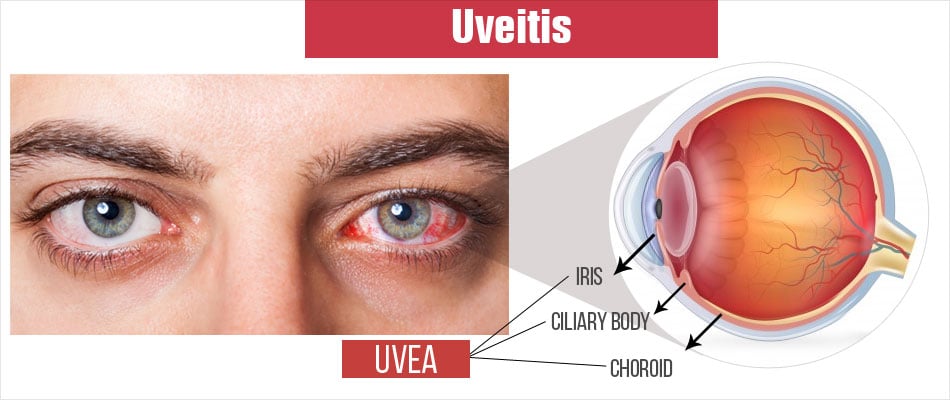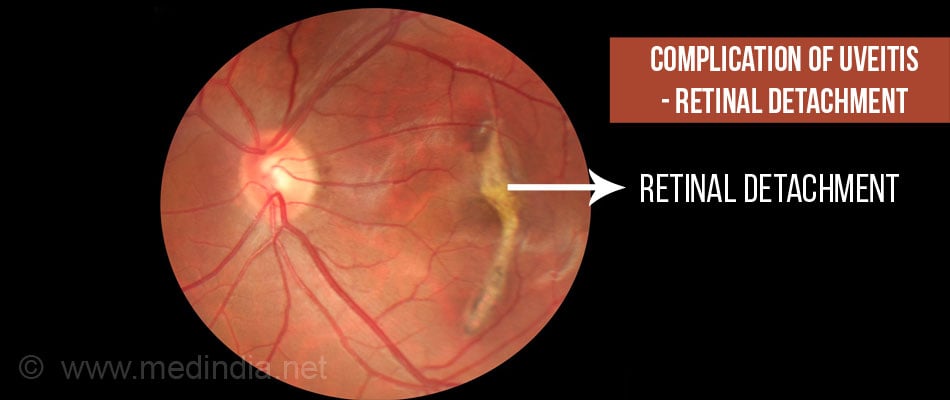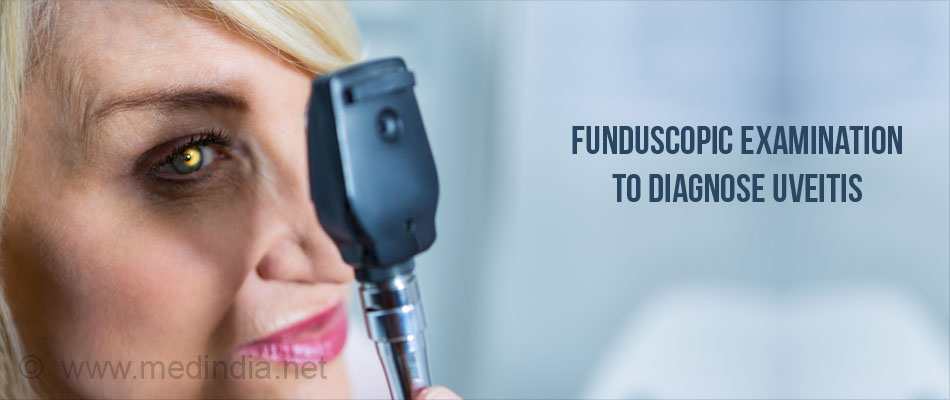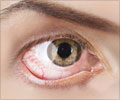- Uveitis - (http://www.mayoclinic.org/diseases-conditions/uveitis/basics/definition/con-20026602)
- Diet & Nutrition - (http://www.aoa.org/patients-and-public/caring-for-your-vision/diet-and-nutrition?sso=y)
- Anterior Uveitis - (http://www.aoa.org/patients-and-public/eye-and-vision-problems/glossary-of-eye-and-vision-conditions/anterior-uveitis?sso=y)
- Facts About Uveitis - (https://nei.nih.gov/health/uveitis/uveitis)
- 5 Top Foods for Eye Health - (http://www.eatright.org/resource/health/wellness/preventing-illness/5-top-foods-for-eye-health)
What is Uveitis?
Uveitis refers to inflammation of the uvea or the middle layer of the eye wall which may result in swelling and destruction of eye tissues. It can also affect other parts of the eye including the lens, optic nerve, retina and vitreous humor. It results in a range of outcomes from slight vision loss to severe blindness. It may be the result of a local problem in the eye or an inflammatory disease affecting the body.
Structure of the Eye:
The eye is a globular structure that fits into the eye socket. Ribbon-shaped muscles are attached to its outer surface which help in its movements. The eye consists of three main layers,
- Outer white sclera
- Middle vascular choroid
- Inner light-sensitive layer called the retina
The choroid extends forward as the ciliary body and the iris, which together with the choroid are referred to as the uvea or the uveal tract. The iris (the colored ring of the eye) divides the inner part of the eye into an anterior chamber which contains a liquid called aqueous humor and the posterior chamber which contains a jelly-like vitreous humor. It also controls the amount of light entering the eye through the pupil. The lens is attached to the ciliary body via the suspensory ligaments and is located behind the iris. The nerve signals are carried from the retina via the optic nerve to the brain.

What are the Types of Uveitis?
There are different types of uveitis depending on which part of the eye it affects. These include:
Anterior Uveitis: It is the most common form of uveitis which affects the iris with or without the ciliary body. It occurs predominantly in young and middle-aged people. It may be caused by rheumatologic, skin, lung, gastrointestinal and infectious diseases.
Intermediate Uveitis/Pars Planitis: Intermediate uveitis affects the vitreous humor. It commonly occurs in young adults, who may be suffering from other conditions like sarcoidosis (inflammatory disease) and multiple sclerosis.
Posterior Uveitis/ Choroiditis/ Chorioretinitis: As the name suggests, posterior uveitis affects the back of the eye involving both the retina and the choroid. It is a rare form of uveitis.
Panuveitis Uveitis/ Diffuse Uveitis: In this form of uveitis, all three layers of the eye are affected by inflammation. Behcet’s disease is a common cause of panuveitis.
What are the Causes of Uveitis?
In several cases, the cause of uveitis is not known. Some causes of uveitis are listed below:
- Inflammatory or autoimmune conditions like Crohn's disease, ulcerative colitis, Behcet’s disease, sarcoidosis, ankylosing spondylitis and multiple sclerosis
- Infections such as cat-scratch disease, syphilis, herpes zoster, toxoplasmosis Lyme disease, tuberculosis, or West Nile virus infection
- Cancers such as lymphoma affecting the eye
- Toxins that may penetrate the eye
- Trauma to the eye

What are the Symptoms of Uveitis?
Uveitis can affect either one or both the eyes. The symptoms develop rapidly and depend on the type of the uveitis. They include:
- Blurred vision
- Dark, floating spots in the vision (floaters) which are commonly observed with intermediate uveitis
- Redness of the eye
- Sensitivity to light (photophobia)
- Eye pain which mainly occurs with anterior uveitis
- Vision loss, which occurs in posterior uveitis
The patient may also show the presence of the underlying condition that caused the uveitis.
What are the Complications of Uveitis?
Once detected, uveitis needs treatment. If left untreated, it could lead to serious complications as follows:
- Glaucoma, where the pressure within the eye increases
- Cataract, or clouding of the lens
- Damage to the optic nerve
- Permanent vision loss
- Retinal detachment, that is, separation of the retina from the globe. Retinal detachment can threaten vision

How do you Diagnose Uveitis?
Diagnosis of uveitis includes various tests. A central nervous system (CNS) evaluation is carried out in patients with intermediate uveitis or pars planitis because it is often associated with multiple sclerosis.
Eye examinations include:
Eye Chart or Visual Acuity Test: This test is performed to measure the patient’s vision power and to determine whether it has decreased.
Ocular Pressure: Instruments, such as a tonometer or a tonopen, are used to measure the pressure inside the eye. Prior to this test, eye drops that numb the eye might be suggested.
Slit Lamp Exam/Biomicroscopy: A slit-lamp examination is a non-invasive test which examines the front and back parts of the eye and can detect any changes associated with uveitis.
Vitreous Biopsy is obtained either through aspiration or a surgical procedure called pars plana vitrectomy where the entire vitreous is removed. The vitreous sample is then tested for infections, inflammatory and other cells, and the presence of antibodies.
Funduscopic Exam: This examination is used to evaluate the fundus of the eye to detect the presence of disease conditions affecting the eye. The pupil is dilated using eye drops and the eye is then examined with an instrument called an ophthalmoscope.

Tests should also be carried out to investigate the likely underlying cause of the uveitis.
How do you Treat Uveitis?
The treatment depends on the type and cause of uveitis.
Anterior uveitis is treated with eye drops that dilate the pupil. When administered, these eye drops relax the muscles in the eyes, thus relieving pain. They also reduce the risk of the iris sticking to the lens.
Antibiotic or antiviral medications are given for bacterial and viral infections respectively, with or without corticosteroids.
Severe uveitis may require biologics like adalimumab and infliximab.
Immunosuppressive drugs may be needed to treat underlying cause.
Surgery may be needed to remove the vitreous in the eye or implant a medication-releasing device into the eye.
Corticosteroid eye drops are used to reduce inflammation in uveitis. They may be administered as an injection in intermediate or posterior uveitis, or through implantation of a device that releases the drug slowly and in a sustained manner.

Health Tips
Nutrients in food help prevent a wide range of eye diseases. Taking good care of your eyes is also vital for leading a healthy lifestyle.
Include green leafy vegetables (kale, spinach), sweet potatoes, carrots, strawberries in your diet to keep your eyes healthy.
Adding powerful antioxidants like lutein and zeaxanthin (green leafy vegetables and eggs), vitamin C (fruits and vegetables), vitamin E (nuts, fortified cereals), omega-3 fatty acids (fish oil from salmon or halibut) and zinc can improve eye health.
 MEDINDIA
MEDINDIA

 Email
Email








